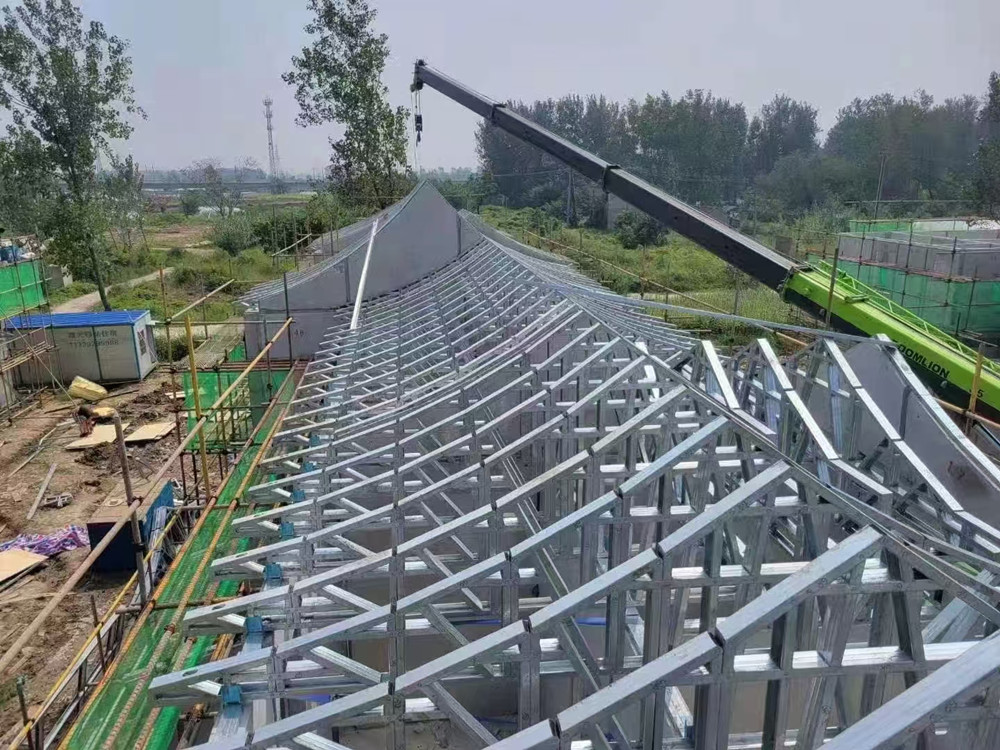The foundation of a steel structure villa is critical to ensuring structural integrity, longevity, and adaptability to environmental conditions. Unlike traditional concrete buildings, steel-framed villas demand specialized foundation solutions due to their lightweight nature, susceptibility to differential settlement, and unique load distribution. Below is a comprehensive analysis of foundation types, selection criteria, and cutting-edge innovations tailored to 2025 standards.

1. Foundation Types for Steel Villas
A. Shallow Foundations
Spread Footings (Isolated Foundations)
- Design: Reinforced concrete pads placed under steel columns to distribute vertical loads.
- Best For: Stable soil (e.g., dense clay, gravel) with high bearing capacity (≥150 kPa).
- Case Study: In Arizona’s Sonoran Desert, villas use laser-leveled footings with epoxy-coated rebar to combat soil alkalinity.
Raft Foundations (Mat Foundations)
- Design: A single thick concrete slab covering the entire footprint, ideal for soft or expansive soils.
- Innovation: Floating Rafts with integrated shock absorbers in Japan’s earthquake zones to isolate seismic forces.
B. Deep Foundations
Pile Foundations
- Types: Driven steel H-piles, helical piles, or concrete-filled tubular piles.
- Best For: Marshy, sandy, or liquefaction-prone soils (e.g., coastal Florida villas using galvanized helical piles).
- Tech Advance: AI-driven pile load testing (e.g., Pile Dynamics Inc.’s PDA-G5) optimizes depth and diameter.
Caisson Foundations
- Design: Drilled shafts filled with reinforced concrete, often socketed into bedrock.
- Case Study: Swiss Alps villas employ rock-socketed caissons to withstand frost heave and slope instability.

2. Key Selection Criteria
A. Geotechnical Factors
- Soil Bearing Capacity: Determined via CPT (Cone Penetration Testing) or SPT (Standard Penetration Test).
- Water Table: High groundwater levels may require waterproofed foundations or buoyancy control (e.g., UAE villas with anti-flotation slabs).
- Frost Depth: In cold climates (e.g., Canada), foundations extend below frost line (1.5–2 m) to prevent heaving.
B. Structural Load Analysis
- Dead vs. Live Loads: Steel villas typically impose 30–50% lighter dead loads than concrete, but wind/snow loads dominate in open designs.
- Dynamic Loads: For earthquake zones (e.g., California), base isolators or tuned mass dampers integrate with foundations.
C. Sustainability Goals
- Low-Carbon Concrete: Foundations using geopolymer concrete (e.g., CarbiCrete) reduce CO2 by 70%.
- Recycled Materials: Steel slag aggregates in concrete mixes, as mandated in EU’s Circular Economy Act 2024.

3. Advanced Techniques for 2025
3D-Printed Foundations
- Process: Robotic arms extrude fast-curing concrete in optimized lattice patterns, slashing material use by 40%.
- Project: Dubai’s “Steel Oasis” villa used 3D-printed foundations completed in 72 hours.
Smart Sensor-Embedded Foundations
- Function: Fiber-optic sensors monitor strain, temperature, and corrosion in real time, linked to BIM (Building Information Modeling) systems.
- Example: Singapore’s “NeoSteel Homes” program uses self-diagnosing foundations to predict maintenance needs.
Hybrid Foundations with Energy Storage
- Design: Hollow foundation sections house geothermal heat exchangers or phase-change materials (PCMs) for thermal regulation.
- Case Study: Norway’s “Zero Cabin” stores summer heat in foundation PCMs to warm interiors during winter.
4. Region-Specific Solutions
| Region | Challenge | Foundation Strategy |
| Tropical Coastal | Salt corrosion + high winds | Stainless steel pile caps + sacrificial anodes |
| Arid Deserts | Soil erosion + thermal shift | Deep strip footings with reflective coatings |
| Permafrost Zones | Thaw instability | Thermosyphon-equipped piles to stabilize ground temps |
| Urban Slopes | Limited space + landslides | Micropile grids with soil-nailing reinforcement |

5. Construction Best Practices
Pre-Construction Phase
- Geophysical Surveys: LiDAR and ground-penetrating radar (GPR) map subsurface voids or utilities.
- Modular Coordination: Precast foundation blocks align with steel column grids for error-free assembly.
Anti-Corrosion Measures
- Cathodic Protection: Impressed current systems for coastal foundations.
- Coatings: Zinc-rich primers + polyurethane sealants on steel embedments.
Post-Construction Compliance
- Settlement Monitoring: Automated tiltmeters and drones track foundation movement over 5 years.
- Carbon Audits: Track embodied carbon via tools like One Click LCA to meet net-zero certifications.
Future Trends in Foundation Design
- Self-Healing Concrete: Microcapsules releasing limestone-producing bacteria (e.g., BioMason) repair cracks autonomously.
- Hydrogen-Powered Pile Drivers: Zero-emission machinery aligns with California’s 2030 Fossil-Free Construction Mandate.
- Space-Efficient “Nested Foundations”: Stackable foundations for modular villas in high-density cities like Tokyo.
Conclusion: Balancing Precision and Adaptability
The foundation for a steel structure villa is no longer a static component but a dynamic interface between architecture and environment. By leveraging geotechnical data, smart materials, and climate-responsive designs, modern foundations ensure steel villas remain resilient against 21st-century challenges—from rising sea levels to resource scarcity. As the industry shifts toward AI-driven customization and circular economy principles, the “invisible” foundation will increasingly become the cornerstone of sustainable luxury living.